General Sir John Monash, Personal Files Book 17, 11 February - 18 March 1918, Part 10
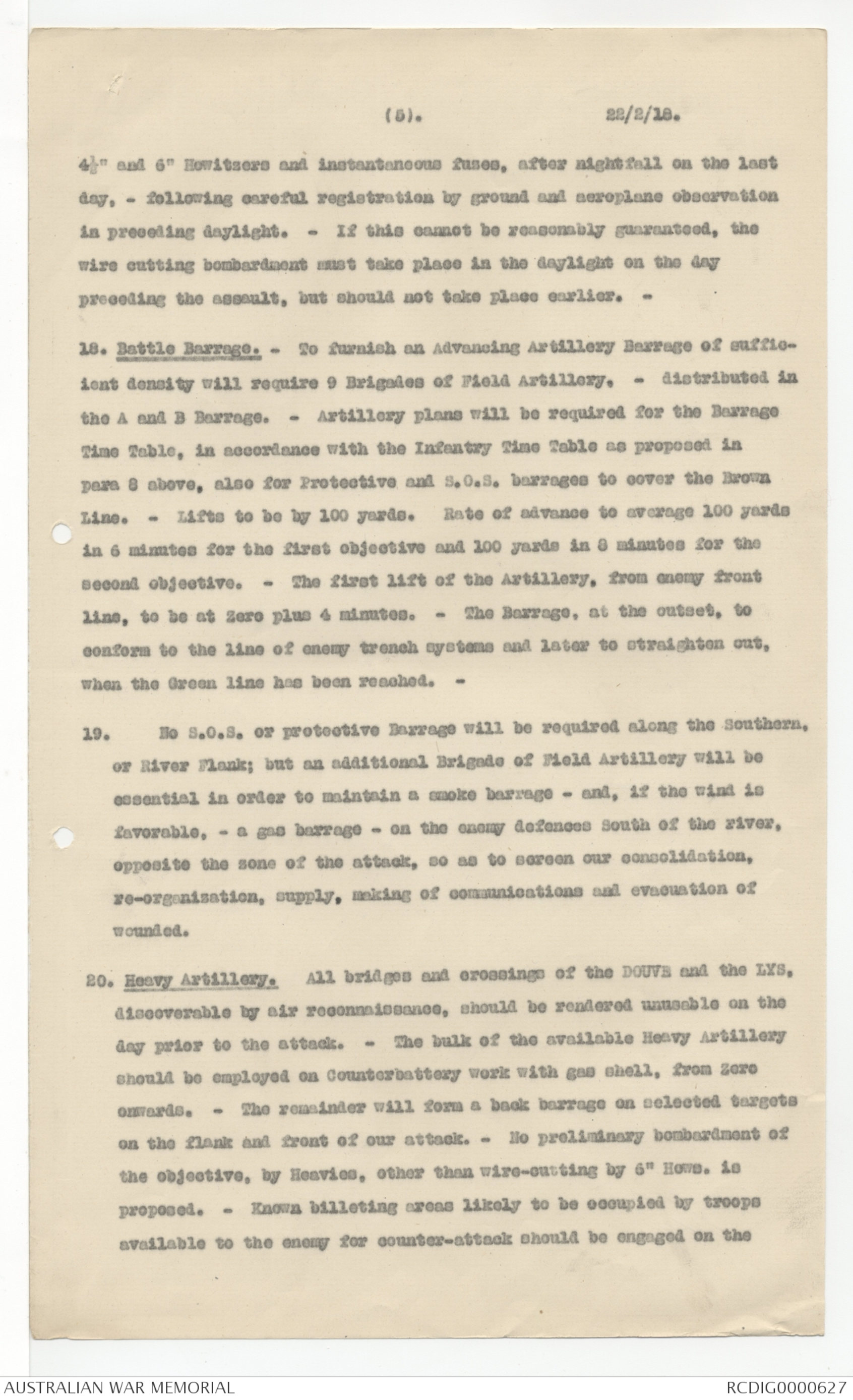
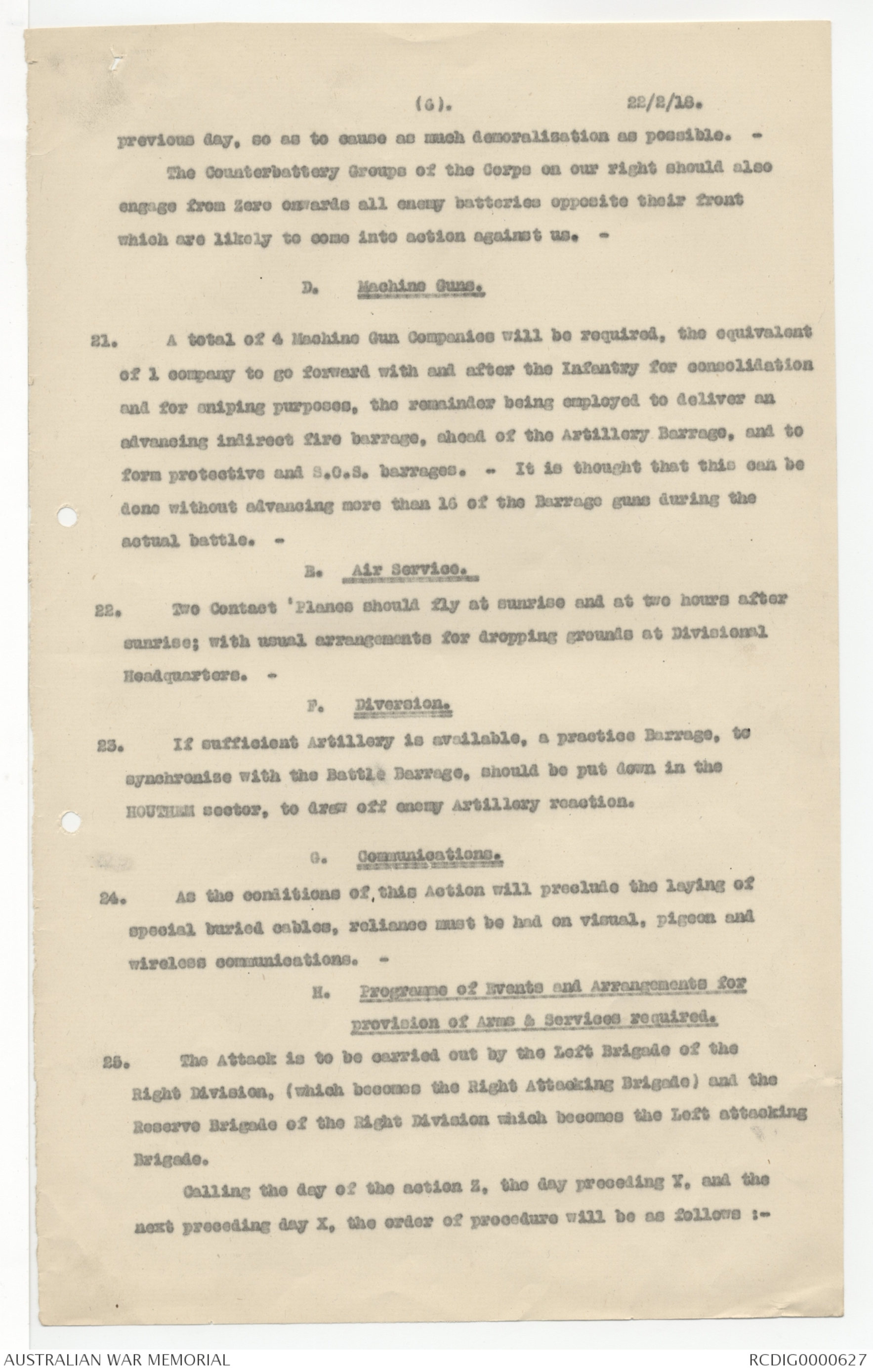
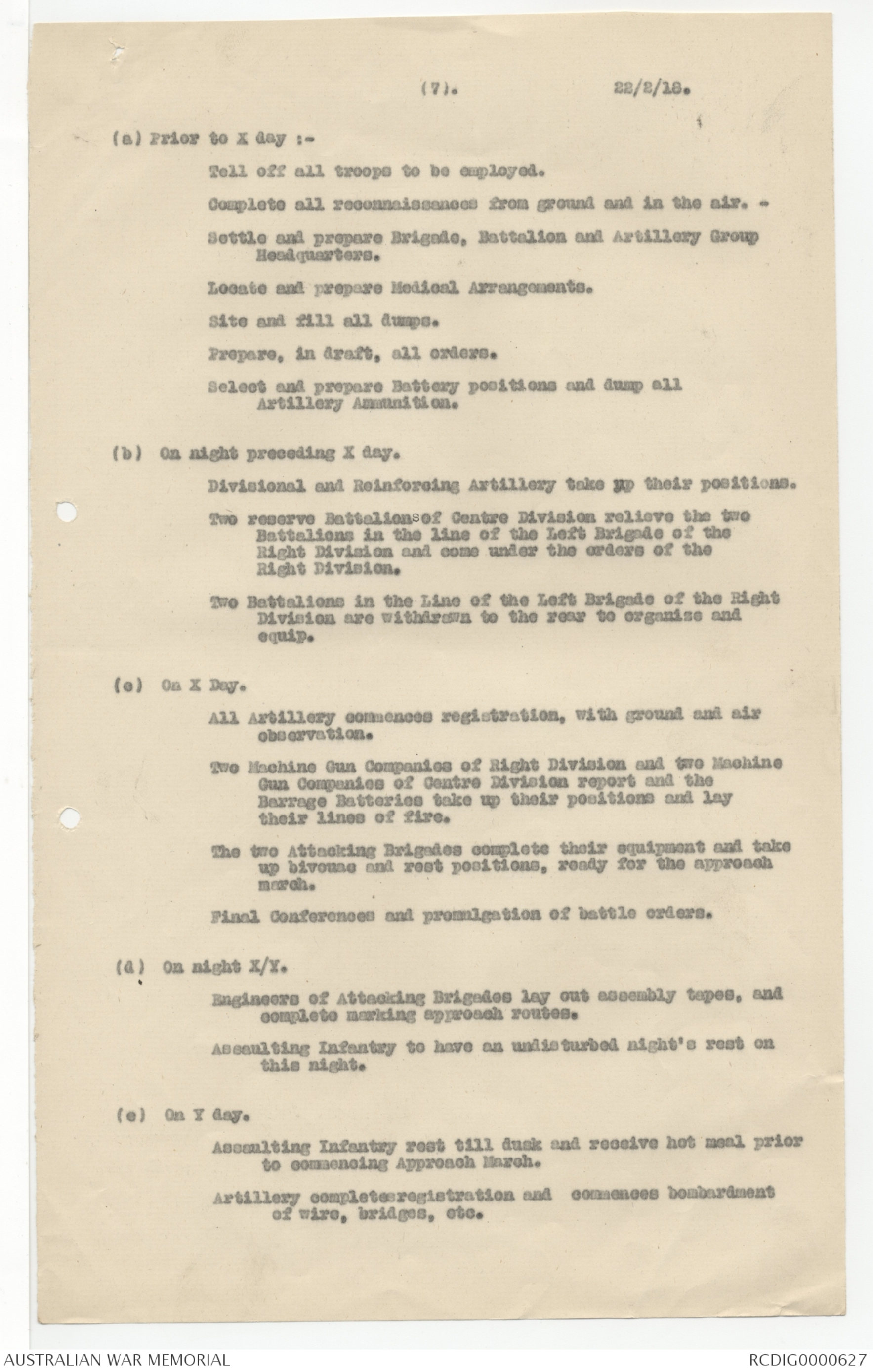
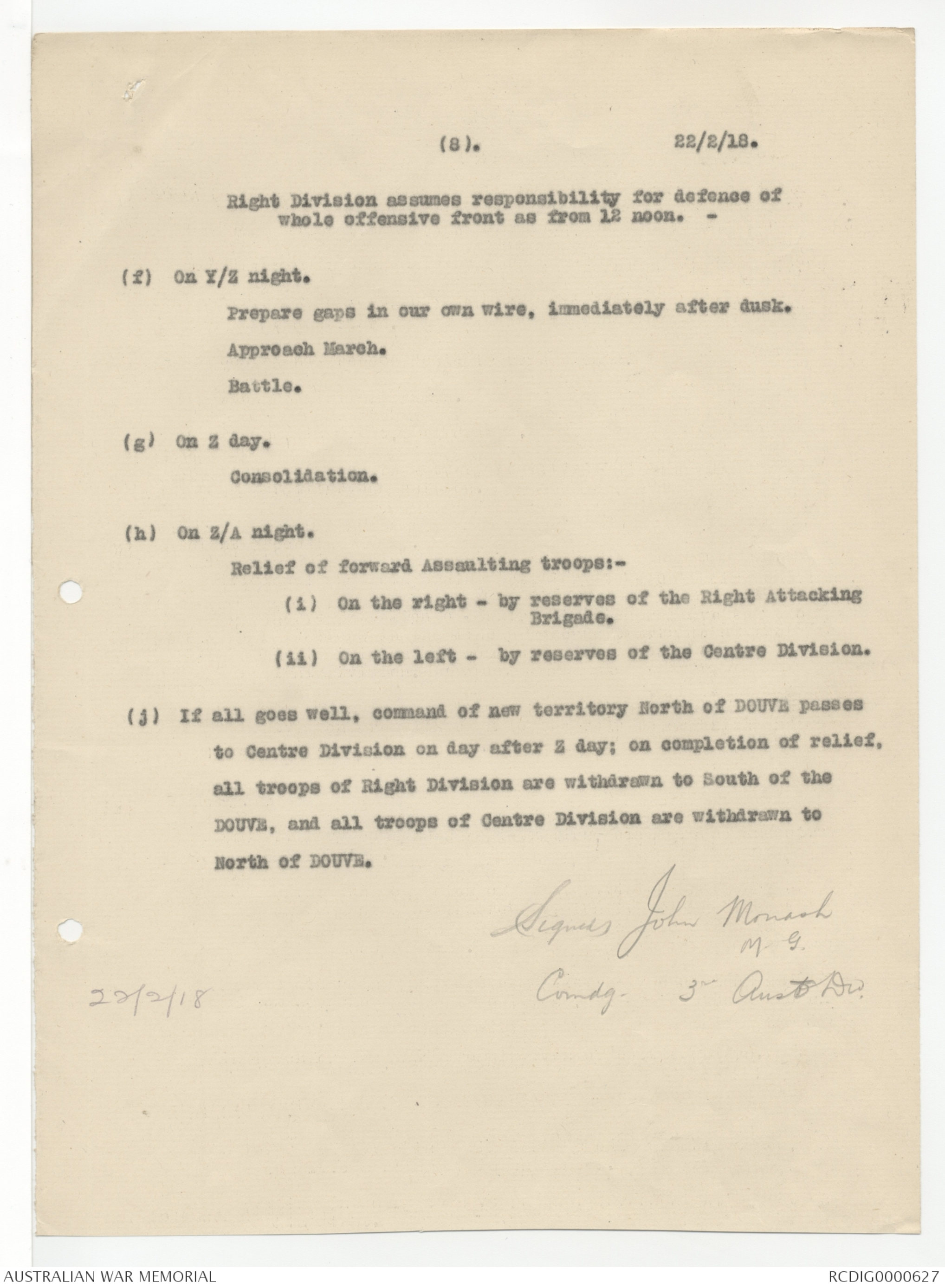
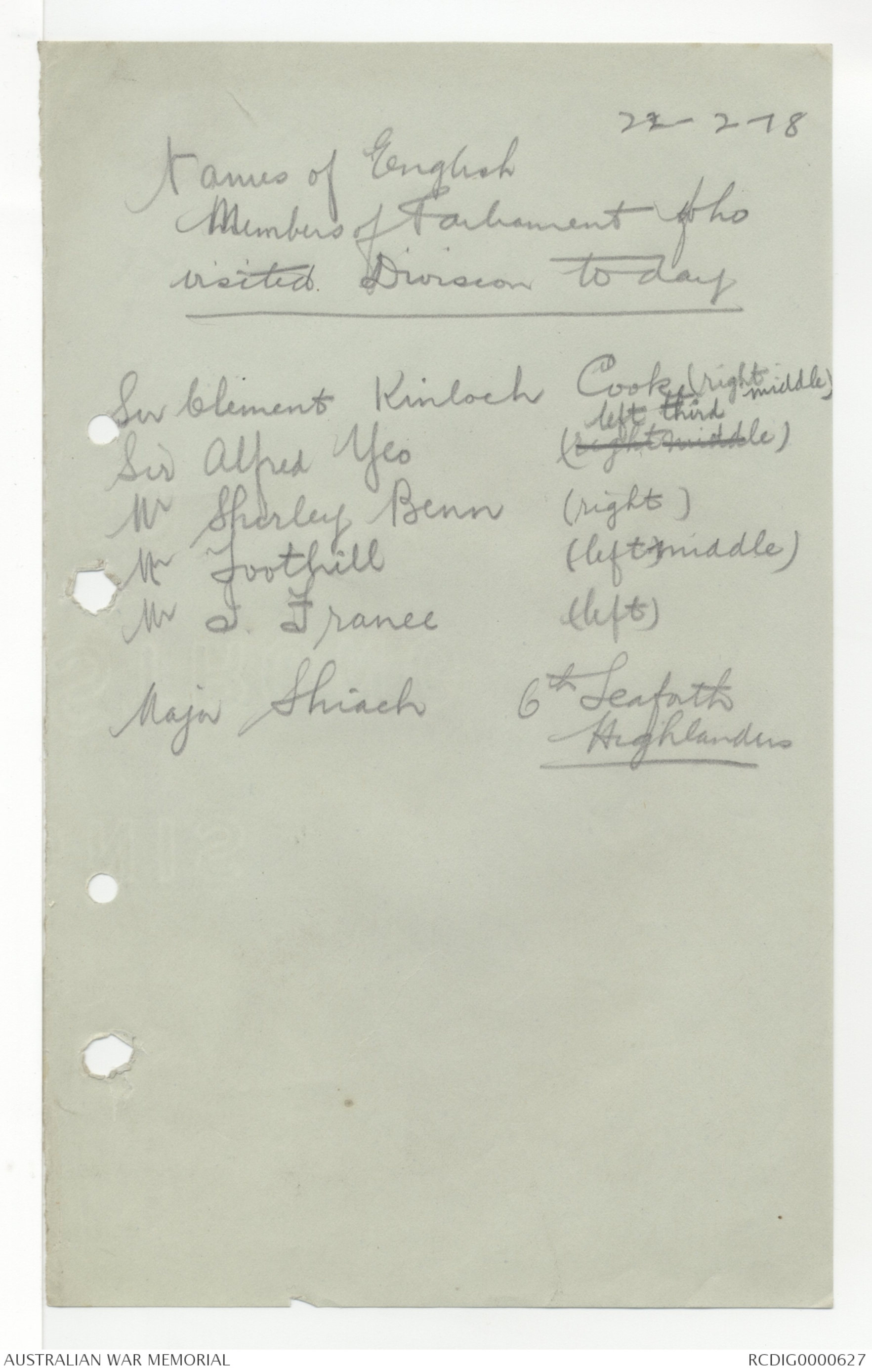
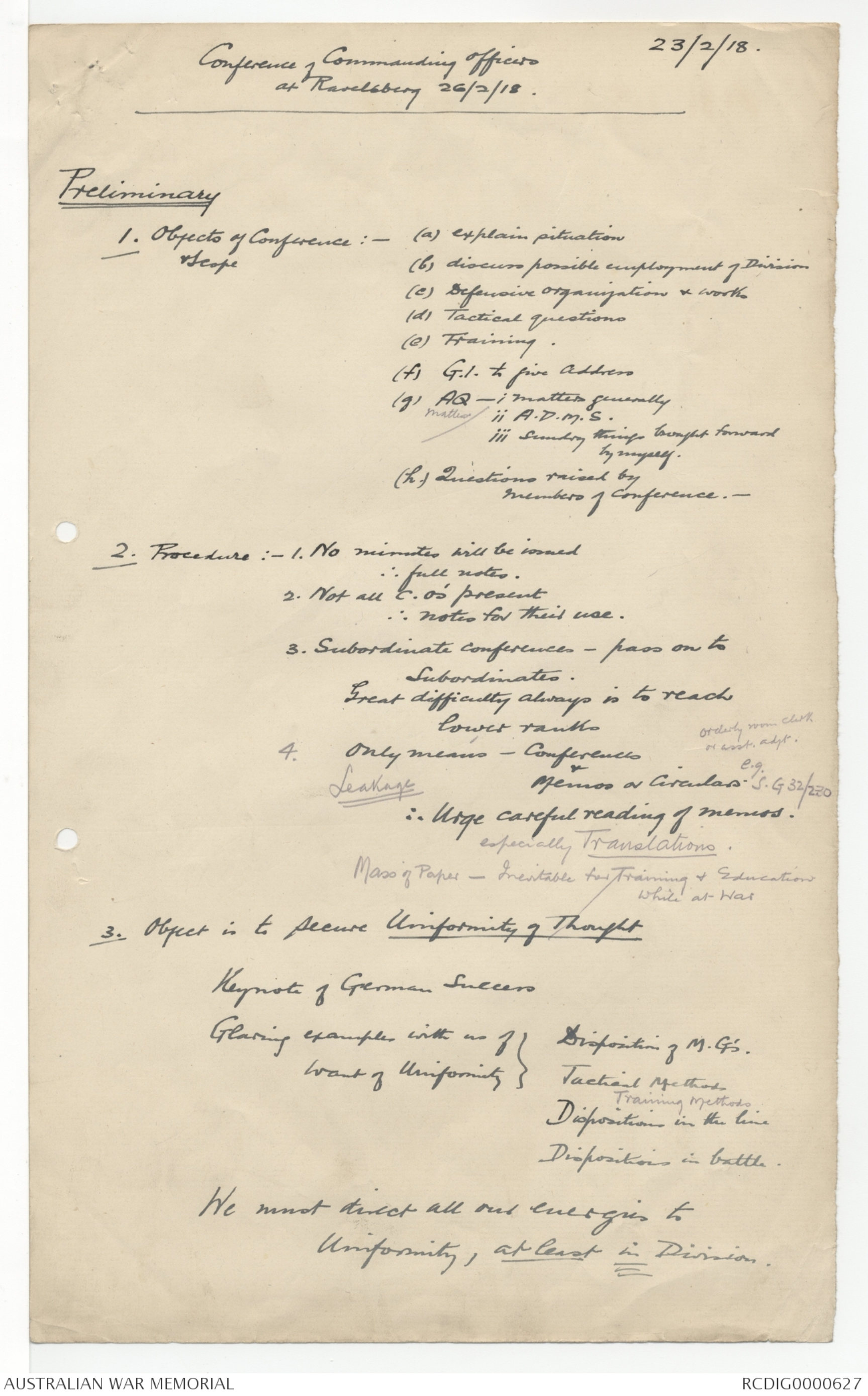

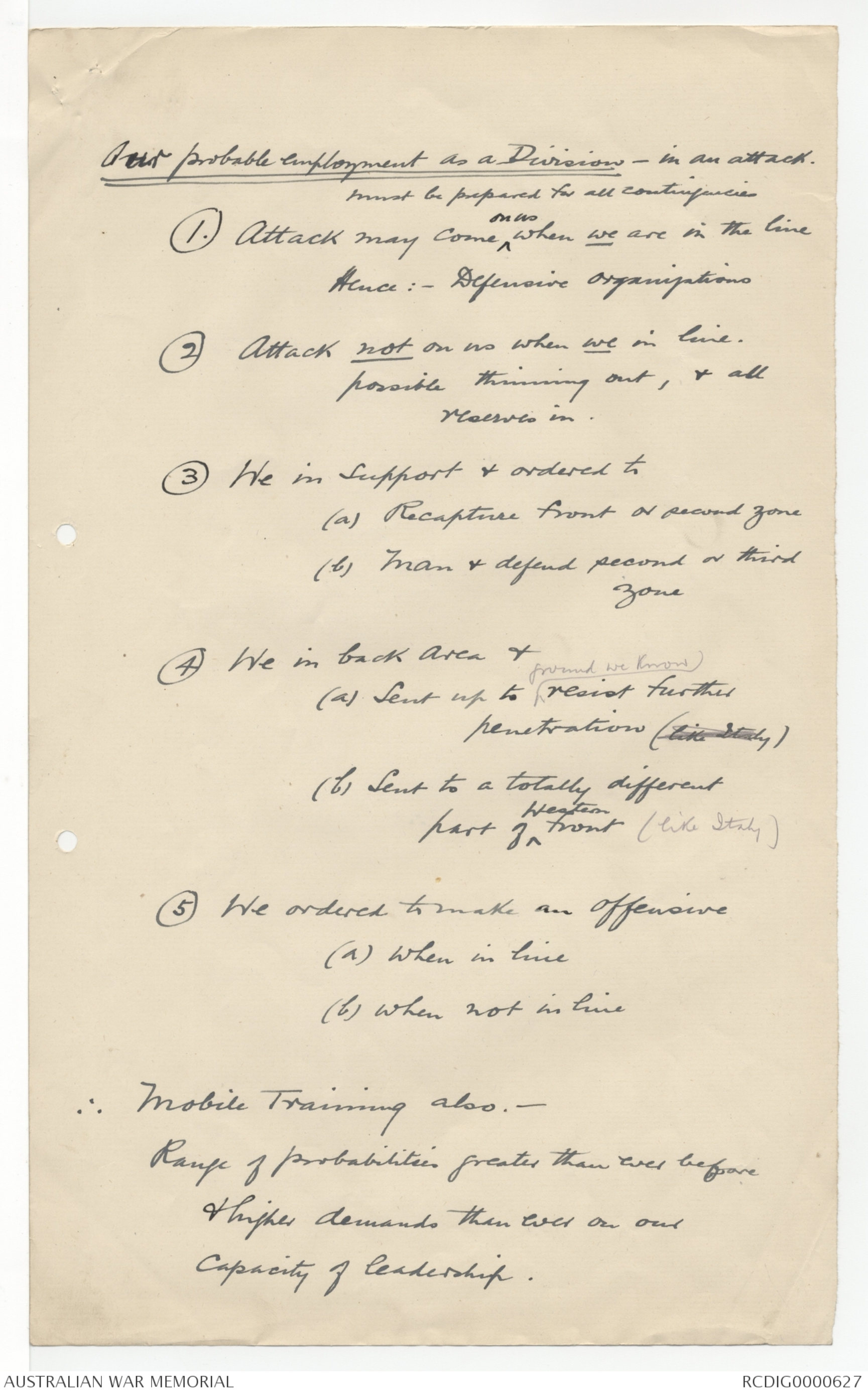
(5). 22/2/18.
4½" and 6" Howitzers and instantaneous fuses, after nightfall on the last
day, – following careful registration by ground and aeroplane observation
in preceding daylight. – If this cannot be reasonably guaranteed, the
wire cutting bombardment must take place in the daylight on the day
preceding the assault, but should not take place earlier. –
18. Battle Barrage. To furnish an Advancing Artillery Barrage of sufficient
density will require 9 Brigades of Field Artillery, – distributed in
the A and B Barrage. – Artillery plans be required for the Barrage
Time Table, in accordance with the Infantry Time Table as proposed in
para 8 above, also for Protective and S.O.S. barrages to cover the Brown
Line. – Lifts to be by 100 yards. Rate of advance to average 100 yards
in 6 minutes for the first objective and 100 yards in 8 minutes for the
second objective. – The first lift of the Artillery, from enemy front
line, to be at Zero plus 4 minutes. – The Barrage, at the outset, to
conform to the line of enemy trench systems and later to straighten out,
when the Green line has been reached. –
19. No S.O.S. or protective Barrage will be required along the Southern,
or River Flank; but an additional Brigade of Field Artillery will be
essential in order to maintain a smoke barrage – and, if the wind is
favorable, – a gas barrage – on the enemy defences South of the river.
opposite the zone of the attack, so as to screen our consolidation,
re-organization, supply, making of communications and evacuation of
wounded.
20. Heavy Artillery. All bridges and crossings of the DOUVE and the LYS,
discoverable by air reconnaissance, should be rendered unusable on the
day prior to the attack. – The bulk of the available Heavy Artillery
should be employed on Counterbattery work with gas shell, from zero
onwards. – The remainder will form a back barrage on selected targets
on the flank and front of our attack. – No preliminary bombardment of
the objective, by Heavies, other than wire-cutting by 6" Hows. is
proposed. – Known billeting areas likely to be occupied by troops
available to the enemy for counter-attack should be engaged on the
(6). 22/2/18.
previous day, so as to cause as much demoralisation as possible. –
The Counterbattery Groups of the Corps on our right should also
engage from zero onwards all enemy batteries opposite their front
which are likely to come into action against us. –
D. Machine Guns.
21. A total of 4 Machine Gun Companies will be required, the equivalent
of 1 company to go forward with and after the Infantry for consolidation
and for sniping purposes, the remainder being employed to deliver an
advancing indirect fire barrage, ahead of the Artillery Barrage, and to
form protective and S.O.S. barrages. – It is thought that this can be
done without advancing more than 16 of the Barrage guns during the
actual battle. –
E. Air Service.
22. Two Contact 'Planes should fly at sunrise and at two hours after
sunrise; with usual arrangements for dropping grounds at Divisional
Headquarters. –
F. Diversion.
23. If sufficient Artillery is available, a practice Barrage, to
synchronize with the Battle Barrage, should be put down in the
HOUTHEM sector, to draw off enemy Artillery reaction.
G. Communications.
24. As the conditions of this Action will preclude the laying of
special buried cables, reliance must be had on visual, pigeon and
wireless communications. –
H. Programme of Events and Arrangements for
provision of Arms & Services required.
25. The Attack is to be carried out by the Left Brigade of the
Right Division, (which becomes the Right Attacking Brigade) and the
Reserve Brigade of the Right Division which becomes the Left attacking
Brigade.
Calling the day of the action Z, the day preceding Y, and the
next preceding day X, the order of procedure will be as follows:–
(7). 22/2/18.
(a) Prior to X day :–
Tell off all troops to be employed.
Complete all reconnaissances from the ground and in the air. –
Settle and prepare Brigade, Battalion and Artillery Group
Headquarters.
Locate and prepare Medical Arrangements.
Site and fill all dumps.
Prepare, in draft, all orders.
Select and prepare Battery positions and dump all
Artillery Ammunition.
(b) On night preceding X day.
Divisional and Reinforcing Artillery take up their positions.
Two reserve Battalions of Centre Division relieve the two
Battalions in the line of the Left Brigade of the
Right Division and come under the orders of the
Right Division.
Two Battalions in the Line of the Left Brigade of the Right
Division are withdrawn to the rear to organize and
equip.
(c) On X Day
All Artillery commences registration, with ground and air
observation.
Two Machine Gun Companies of Right Division and two Machine
Gun Companies of Centre Division report and the
Barrage Batteries take up their position and lay
their lines of fire.
The two Attacking Brigades complete their equipment and take
up bivouac and rest positions, ready for approach
march.
Final Conferences and promulgation of battle orders.
(d) On night X/Y.
Engineers of Attacking Brigades lay out assembly tapes, and
complete marking approach routes.
Assaulting Infantry to have an undisturbed night's rest on
this night.
(e) On Y day.
Assaulting Infantry rest till dusk and receive hot meal prior
to commencing Approach March.
Artillery completes registration and commences bombardment
of wire, bridges, etc.
(8). 22/2/18.
Right Division assumes responsibility for defence of
whole offensive front as from 12 noon. –
(f) On Y/Z night.
Prepare gaps in our own wire, immediately after dusk.
Approach March.
Battle.
(g) On Z day.
Consolidation.
(h) On Z/A night.
Relief of forward Assaulting troops:-
(i) On the right – by reserves of the Right Attacking
Brigade.
(ii) On the left – by reserves of the Centre Division.
(j) If all goes well, command of new territory North of DOUVE passes
to Centre Division on day after Z day; on completion of relief,
all troops of Right Division are withdrawn to South of the
DOUVE, and all troops of Centre Division are withdrawn to
North of DOUVE.
Signed John Monash
M.G.
Comdg. 3rd Aust Div.
22/2/18
22-2-18
Names of English
Members of Parliament who
visited Division today
Sir Clement Kinloch Cooke (right middle)
Sir Alfred Yeo (right middle left third)
Mr Shirley Benn (right)
Mr Foothill (left middle)
Mr J France (left)
Major Shiach 6th Seaforth
Highlanders
23/2/18.
Conference of Commanding Officers
at Ravelsberg 26/2/18.
Preliminary
1. Objects of Conference & Scope:–
(a) explain situation
(b) discuss possible employment of Division
(c) Defensive organization & works
(d) Tactical questions
(e) Training
(f) G.I. to give address
(g) AQ – i matters generally
[*matters*]
ii A.D.M.S.
iii Sending things brought forward
by myself.
(h) Questions raised by
Members of Conference.–
2. Procedure :– 1. No minutes will be issued
∴ full notes.
2. Not all C.O's present
∴ notes for their use.
3. Subordinate conferences – pass on to
Subordinates.
Great difficulty always is to reach
lower ranks
[*Orderly room Clerk
or asst. adjt.
e.g. S.G 32/230*]*
4. Only means – Conferences
&
Memos or Circulars
[*Leakage*]
∴ urge careful reading of memos.
especially Translations.
Mass of Paper – Inevitable for Training & Education
while at War
3. Object is to secure Uniformity of Thought
Keynote of German success
Glaring examples with us of } Disposition of M.G.'s.
want of Uniformity } Tactical Methods
Training Methods
Dispositions in the line
Dispositions in battle.
We must direct all our energies to
Uniformity, at least in Division.
Situation.
Very little ago – everybody talked peace, – now everybody offensive.-Enemy
Enemy – Will he attack? When? Where? How?
- Not yet a large concentration on West.
Thinks he can concentrate quicker than U.S.A.
Not likely attack till head of men.
Shells &c.
Planes.
Unless driven by internal situation
May be all bluff.
If hunger satisfied – defensive strategy.
If internal affairs compel him
– stake all on a great offensive.
Nature of Offensive
(a) Deliberate – lengthy bombardment
& plenty notice to us.
(by air & agents)
(b) Surprise – like Riga & Cambrai
Corollary in Mass Attacks – in
fairly close formations.
Kinds of Surprise in detail
Aeroplane Scouts. – Tanks. – New Gas. –
Educate troops to this.
Our Situation
No need for pessimism
Our conditions different from Riga
Isonzo
Serbia
Gorlize
because:– (1) No great preponderance
(2) Splendid air service
(3) High moral
Highly developed Rys & roads
(4) our high moral.
Really our great opportunity
Our answer:– ; Alertness against surprise
ii Development of our
fire power
Refer to:– (a) Cambrai & describe briefly
(b) Rawlinson's lecture – Notes by Army S.G. 43/54
(c) "Story of a Great Fight" – to be read
to the men – with excisions.
Although no pessimism, we must put our house in order.
Our probable employment as a Division – in an attack.
must be prepared for all contingencies
(1) Attack may come ^on us when we are in the line
Hence: – Defensive organizations
(2) Attack not on us when we in line.
possible thinning out, & all
reserves in.
(3) We in support & ordered to
(a) Recapture front or second zone
(b) Man & defend second or third
zone
(4) We in back area &
(a) Sent up to ^ground we know resist further
penetration (like Italy)
(b) Sent to a totally different
part of ^Western front (like Italy).
(5) We ordered to make an offensive
(a) When in line
(b) When not in line
∴ Mobile Training also. –
Range of probabilities greater than ever before
& higher demands than ever on our
capacity of leadership.
 Transcriber 8364
Transcriber 8364This transcription item is now locked to you for editing. To release the lock either Save your changes or Cancel.
This lock will be automatically released after 60 minutes of inactivity.